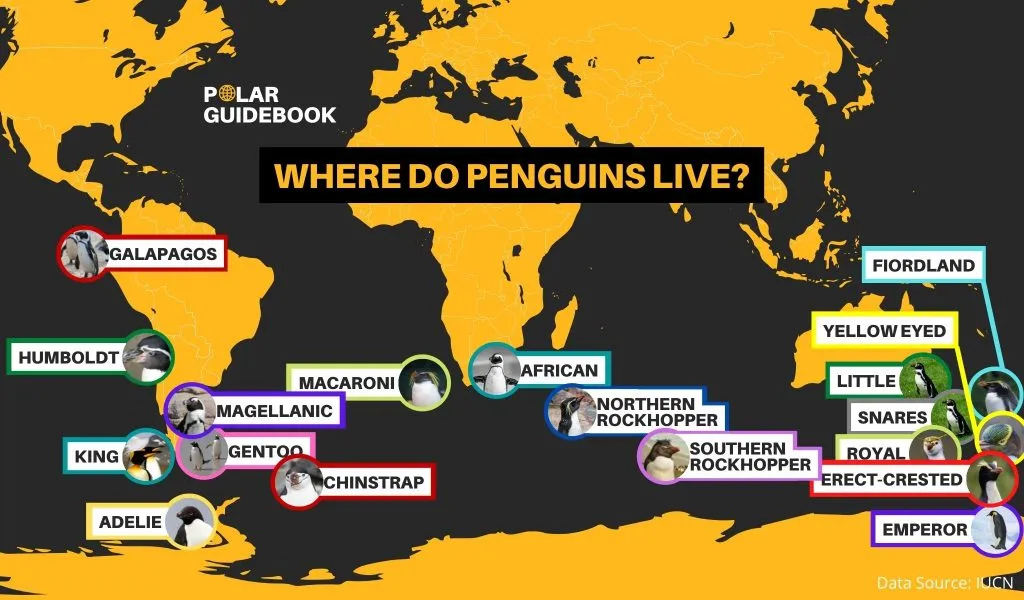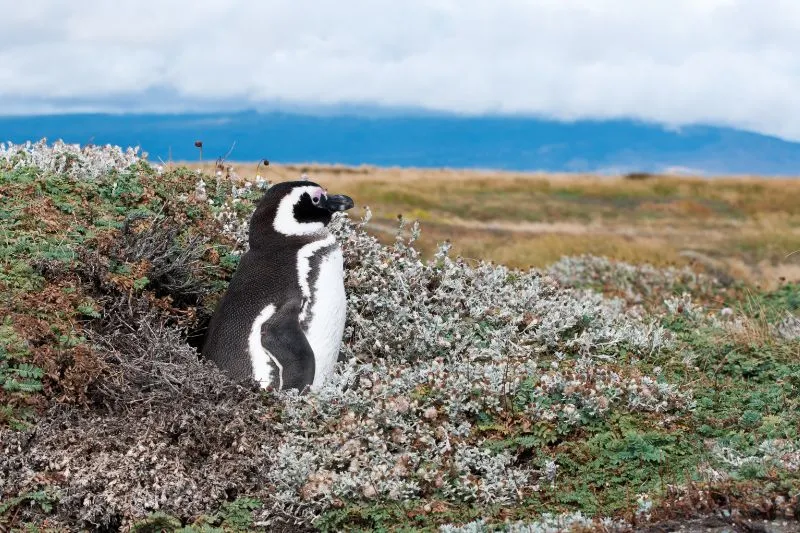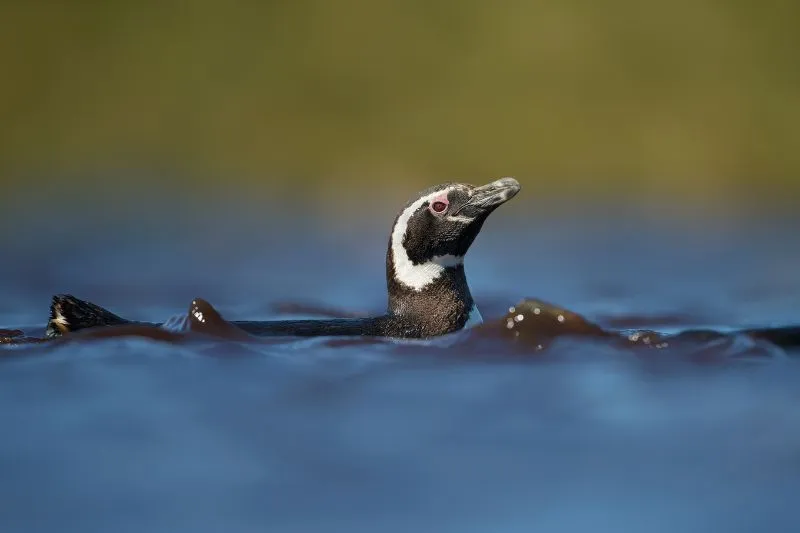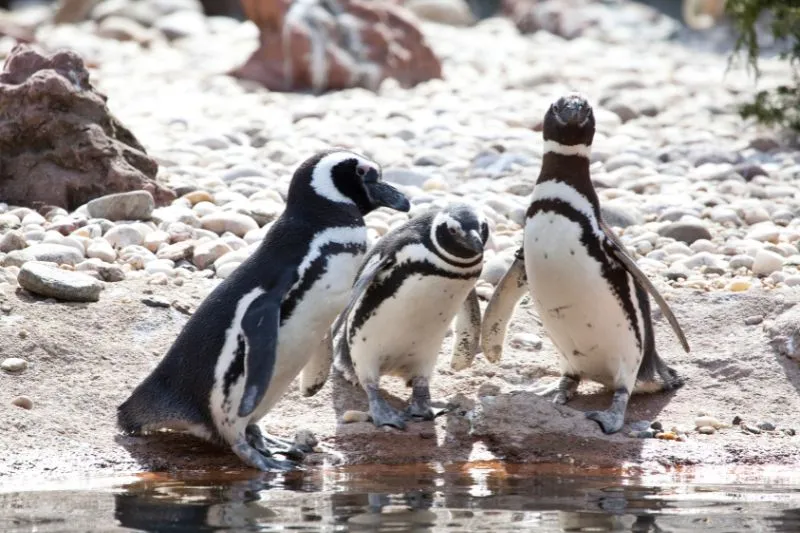Magellanic penguins are a fascinating and beloved species of penguin that live in South America. Not only are they adorable and entertaining to watch, but they also have interesting behaviors that are not what you’d expect from a penguin.
In this article, we will delve into the world of Magellanic penguins and discover some of the most interesting and surprising facts about this remarkable species.
1. Magellanic Penguins live in South America
The Magellanic Penguin can be found on both the Atlantic (east) and Pacific (west) coasts of South America in Argentina, Chile, and the Falkland Islands. During winter, those on the Atlantic coast migrate to northern Argentina, Uruguay, and southern Brazil.
They are found in a range of habitats, including rocky or forested coastal areas, grasslands, and offshore islands1 (source: Britannica). The below graphic maps out where the different penguin species can be found, see our dedicated article to learn more about where penguins live.

2. They are black and white for camouflage
Penguins have a black-and-white coloration known as countershading, which helps them blend in with their surroundings.
Their white belly blends in with the lighter surface waters when viewed from below, while their black back provides camouflage against the darkness of deeper waters when viewed from above2 (source: H.M. Rowland, The Royal Society B Biological Sciences, Issue 364, 2008).
Find out more about the color of penguins eyes, beak, and feet in our full guide to what color are penguins.
3. They usually construct burrows instead of nests

We’re used to seeing penguins build nests on the snow, but Magellanic penguins live on the coasts of South America where there is no snow. Instead of building nests, they usually dig burrows into the soil instead and lay eggs in here.
The burrows can be as deep as 2m and are built in a way that allows the rainwater to collect in a different area than where the eggs are3 (source: Falklands Conservation).
Where this is not possible, they may instead create nests under bushes and in rocky areas.
4. They have a longer life expectancy than any other penguin
Typically, a penguin’s lifespan will be between 15-20 years in the wild. However, Magellanic Penguins have the longest life expectancy of 30 years, they are one of the few species that exceed the lifespan predicted based on their mass, surpassing the prediction by 26%4 (source: J.A. Cerchiara University of Washington).
In captivity, penguins live a little longer, typically around 30 years although there have been documented cases of penguins living to the ripe old age of 40 in captivity.
5. Magellanic penguins can dive as deep as 90m

Penguins may spend around 75% of their day-to-day life in the ocean and use it as a hunting ground for catching prey5 (source: S. Moss, Do Birds Have Knees, 2016) so you won’t be surprised to learn that they are great swimmers and divers.
The deepest recorded depth by Magellanic Penguins is 90m although they mostly forage between 30-60m. Dives can last between 1-3 minutes depending upon the colony6 (sources: Journal of Experimental Biology and Penguins: Natural History and Conservation).
6. Some Magellanic penguins travel over 16,000km per year
Magellanic penguins are known for traveling long distances. Their migration is more than 2,400 miles from Argentina to Brazil and they can travel 170km in one day.
A breeding Magellanic penguin could cover 16,000km in a single year, that’s further than the average car in the United States.
7. Magellanic penguins are very faithful to their partner

Penguins are monogamous which means that they will have only one partner per breeding season with both the male and female playing vital roles in raising offspring.
Although some species of penguin may choose a new mate in the next breeding season (this is called a penguin divorce), Magellanic penguins are noted to be very faithful and typically only find a new mate when they have failed to produce offspring. One pair has been recorded mating for 17 consecutive years at Punta Tomba.
Mate fidelity of Magellanic Penguins is 86% for males and 83% for females7 (source Penguins: Natural History and Conservation). It has been found that fidelity is highly related to breeding success. They are also unlikely to engage in extrapair copulation (cheating on their partner) which is common with other species such as Humboldt Penguins and Little Penguins.
8. Magellanic penguins eat fish, squid, and crustaceans
Magellanic penguins are carnivores, they mostly eat fish, squid, and crustaceans8 (source: P.D. Boersma and P.G. Borboroglu, Penguins: Natural History and Conservation, 2013). North of 46 °S, their main prey is Argentine anchovy whereas south of this, they mostly eat Chilean sprat.
Penguins catch and eat their food at sea. They will catch prey as they swim upwards and swallow it whole without chewing. Magellanic penguins can eat between 1-5g of food per minute9 (source: P.D. Boersma and P.G. Borboroglu, Penguins: Natural History and Conservation, 2013).
Find out more in our full article about what penguins eat.
9. They are one of the most common penguins

With a population of around 2.3-3.2 million, Magellanic penguins are one of the most common types of penguin10 (source: IUCN).
Although some penguin species are endangered, this is not the case with Magellanic penguins which are listed as ‘least concern’, the lowest level of endangerment by the IUCN.
However, they still have a slowly declining population. Particular threats they face come from human activity such as industrial fishing and oil spills.
10. They are medium-sized penguins at 27” tall
Magellanic penguins are 27” (70cm) tall which is about average for a penguin. They weigh around 5kg (11lbs)11 (source: Seaworld) although this can vary by season and be as low as 4lbs (1.8kg) when close to starvation after incubating eggs.
The below graphic shows how Magellanic penguins compare to the size of other penguins.

11. They are closely related to Humboldt and African Penguins
Magellanic penguins are part of a family known as banded penguins. They are very closely related to other banded penguins including Humboldt and African penguins as well as Galapagos penguins to a lesser extent.
They are so similar that some people question whether Magellanic, African, and Humbodlt penguins are different species or not. Especially given that they interbreed together in captivity and when their range overlaps in the wild (such as in Chile where you can find both Magellanic and Humbodlt colonies).
12. They have more predators than other penguin species including sea lions, seals, and foxes
Magellanic penguins’ habitat on the coasts of South American means that they have more predators to worry about than other penguin species, such as those in Antarctica and sub-Antarctic islands.
The main predators of Magellanic penguins are southern sea lions, leopard seals, southern giant petrels, and foxes.
Occasionally, wild cats such as puma will hunt Magellanic penguins. Their eggs must be well protected which is why they tend to build burrows rather than nests. Eggs that are left without cover may be targeted by a range of animals including kelp gulls, skua, skunks, armadillos, and foxes12 (source: P.D. Boersma and P.G. Borboroglu, Penguins: Natural History and Conservation, 2013).
13. They are named after the Portuguese explorer that discovered them

Magellanic penguins are named after the Portuguese explorer Ferdinand Magellan, who first discovered them during his historic journey around the world between 1519-1522.
Although the penguin is named after Magellan, it was one of the crew, Antonio Pigafetta from Italy, who is believed to have been the first to spot the new species13 (source: Britannica).
14. They are able to drink salt water as well as freshwater
Our last fact about Magellanic penguins is that they spend most of their lives at sea or around coastal areas of South America where the only water available for consumption is saltwater.
However, the kidney of a bird (penguins are birds remember!) is famously not very efficient at processing salt so they have a special salt gland (also known as a super orbital gland) at the top of their skull, near their eye, which removes salt from their blood.
The salt is excreted in water droplets through their nostrils by sneezing or shaking their head14 (source: Britannica). This means that penguins don’t need to worry about ingesting salt water as they catch and eat their prey in the sea.


![You are currently viewing 14 Magnificant Facts About Magellanic Penguins [#9 Will Surprise You!]](https://polarguidebook.com/wp-content/uploads/2023/01/Magellanic-penguins-group.jpg)
![Read more about the article 12 Ice-Cool Facts About Adélie Penguins [#9 Will Surprise You]](https://polarguidebook.com/wp-content/uploads/2023/01/Adelie-Penguins-Jumping-Over-Ice-300x200.jpg)

![Read more about the article 14 Humble Facts About Humboldt Penguins [#6 Will Change How You See Them]](https://polarguidebook.com/wp-content/uploads/2023/01/Humboldt-Penguin-2-300x200.jpg)